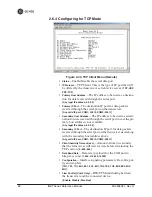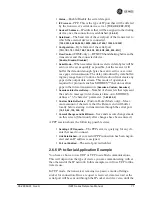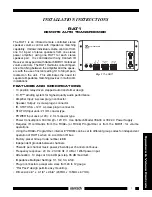
05-2806A01, Rev. H
iNET Series Reference Manual
65
•
IP Protocol
—Point to Multipoint [
TCP, UDP PPP; TCP
]. This is
the type of IP port that will be offered by the
transceiver’s
serial device server.
•
Multicast IP Address
(used instead of
Local IP Address
when
using UDP Point-to-Multipoint.)— Must be configured with
a valid Class D IP address (224.0.0.0–239.255.255.255). IP
packets received with a matching destination address will be
processed by this unit [
Any legal IP address; 0.0.0.0
].
•
Multicast IP Port
(used instead of
Local IP Port
when using UDP
Point-to-Multipoint.)—This port number must match the
number used by the application connecting to local TCP or
UDP socket. [
1-64,000; COM1: 30010, COM2: 30011
]
•
Local IP Port
—Receive IP data from this source and pass it
through to the connected serial device. The port number must
be used by the application connecting to local TCP or UDP
socket. [
Any valid IP port; COM1: 30010, COM2: 30011
]
•
Time to Live (TTL)
—An IP parameter defining the number of
hops that the packet is allowed to traverse. Every router in the
path will decrement this counter by one.
•
Packet Redundancy Mode
— For proper operation, all radios’
Serial Packet Redundancy mode must match (Single Packet
mode vs. Packet Repeat mode). This is because a transceiver,
when in Packet Repeat mode, sends 12 extra characters
(sequence numbers, etc.) to control the delivery of the
repeated data. Misconfigurations can result in undesired
operation.
•
Data Baud Rate
—Data rate (payload) for the
COM
port in
bits-per-second. [
1,200–115,200; 19200
]
•
Con
fi
guration
—Formatting of data bytes, representing data
bits, parity and stop bits. [
7N1, 7E1, 7O1, 8N1, 8E1, 8O1, 8N1, 7N2,
7E2, 7O2, 8N2, 8E2, 8O2; 8N1
]
•
Flow Control [Com2 Only]
—RTS/CTS handshaking between
the transceiver and the connected device. [
Enable, Disable; Dis-
abled
]
•
Serial Mode
—When seamless mode is selected data bytes
entering the serial data port are sent over the radio link with-
out delay, but the receiving end will buffer the data until
enough bytes have arrived to cover worst-case gaps in trans-
mission. The delay introduced by data buffering may range
from 22 to 44 ms, but the radio will not create any gaps in the
output
data stream. This permits operation with protocols
such as MODBUS™ that do not allow gaps in their data
transmission. [
Seamless, Custom; Seamless
]
•
Seamless Inter-Frame Delay
— Amount of time (in number of
characters) that signal the end of a message (inter-character
time-out). UDP packet sizes are delimited and sent out based
on the Seamless Inter-Frame Delay only when receiving data
through the serial port. MODBUS defines a “3.5-character”
setting. [
1–65,535; 4
]
Содержание MDS iNET-II 900
Страница 12: ...2 iNET Series Reference Manual 05 2806A01 Rev H...
Страница 32: ...22 iNET Series Reference Manual 05 2806A01 Rev H...
Страница 122: ...112 iNET Series Reference Manual 05 2806A01 Rev H...
Страница 124: ...114 iNET Series Reference Manual 05 2806A01 Rev H...
Страница 136: ...126 iNET Series Reference Manual 05 2806A01 Rev H...
Страница 138: ...128 iNET Series Reference Manual 05 2806A01 Rev H...
Страница 162: ...152 iNET Series Reference Manual 05 2806A01 Rev H...
Страница 164: ...154 iNET Series Reference Manual 05 2806A01 Rev H...
Страница 174: ...164 iNET Series Reference Manual 05 2806A01 Rev H...
Страница 182: ...172 iNET Series Reference Manual 05 2806A01 Rev H...
Страница 190: ...GE MDS LLC Rochester NY 14620 General Business 1 585 242 9600 FAX 1 585 242 9620 Web www GEmds com 175 Science Parkway...
















































